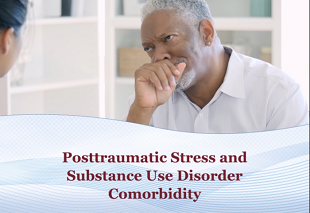PTSD: National Center for PTSD
Treatment of Co-Occurring PTSD and Substance Use Disorder in VA
Treatment of Co-Occurring PTSD and Substance Use Disorder in VA
Key Points
- Posttraumatic stress disorder (PTSD) and substance use disorder (SUD) often co-occur.
- Patients with PTSD and SUD can tolerate and benefit from evidence-based trauma-focused PTSD treatment.
- Per VA /DoD Clinical Practice Guidelines, patients with PTSD and SUD should be offered evidence-based treatment for both disorders. Having one should not be a barrier to receiving treatment for the other.
- Shared decision making about treatment for co-occurring PTSD and SUD using a patient-centered collaborative approach that incorporates measurement based care (MBC) is recommended.
In This Article
Prevalence and Characteristics
PTSD and SUD often co-occur. According to a large national epidemiologic study, 44.6% of individuals with lifetime PTSD also met criteria for an alcohol use disorder (AUD) or SUD (1) and having PTSD at any point is associated with increased likelihood of a SUD diagnosis (2). When looking at the subset of veterans in the study, those with lifetime PTSD were found to be 2 times more likely to meet the criteria for an AUD, 3 times more likely for a drug use disorder, and over 3 times more likely for a nicotine use disorder (3).
Continuing Education Course
Posttraumatic Stress and Substance Use Disorder Comorbidity
This PTSD 101 online course describes the correlates of co-occurring PTSD and SUD, treatment research and VA/DoD Clinical Practice Guideline recommendations.
Information about treatment-seeking Veterans comes primarily from VA administrative data. For example, in a study of veterans from Iraq and Afghanistan it was found that among those with a lifetime diagnosis of PTSD, 34.2% of men also had an AUD, and 17.3% had a SUD (4). For women 20.1% had an AUD, while 10.5% had a SUD (4).
Although PTSD and SUD are each associated with functional impairment, on average, individuals who have both disorders have poorer treatment outcomes, more additional psychiatric problems, and more functional problems across multiple domains, including medical, legal, financial, and social, than those with just one disorder (5-8).
Research Regarding the Treatment of Co-Occurring PTSD and SUD
Psychotherapy
Individuals with PTSD and SUD can safely engage in and benefit from trauma-focused, cognitive behavioral psychotherapies for PTSD recommended in the VA/DoD Clinical Practice Guideline for PTSD such as Prolonged Exposure (PE), Cognitive Processing Therapy (CPT), and Eye Movement Desensitization and Reprocessing (EMDR) therapy (9). A participant level meta-analysis called Project Harmony combined and analyzed individual patient data from 36 randomized controlled trials of psychological and pharmacological treatment for PTSD and SUD. Results showed that integrated, trauma-focused interventions that address both disorders have the greatest benefit relative to treatment as usual (10) and other non-trauma focused, single-disorder, or control condition approaches (11).
A study-level meta-analysis also concluded that patients with PTSD and SUD who received trauma-focused cognitive behavioral psychotherapy for PTSD along with SUD treatment were more likely to reduce their PTSD symptoms and alcohol use than were patients who received SUD only treatment or treatment as usual (12). They found that effect sizes were small and dropout rates were high regardless of the intervention delivered. In some studies, participants received trauma-focused therapy concurrently with SUD psychotherapy (e.g., 13) while in other studies, trauma-focused PTSD treatment and SUD psychotherapy were integrated into a single intervention. For example, Concurrent Treatment of PTSD and Substance Use Disorders Using Prolonged Exposure (COPE) integrates Prolonged Exposure therapy for PTSD with relapse prevention for SUD. Studies of COPE with Veteran and non-Veteran samples have shown COPE to outperform treatment as usual and relapse prevention for PTSD symptom reduction (14,15).
Both Project Harmony studies and the meta-analysis found that therapies that were not trauma-focused and instead centered on improving coping skills did not have better PTSD or SUD outcomes than SUD only treatment or treatment as usual. For example, Seeking Safety, an integrated psychotherapy focused on improving coping skills that does not include trauma processing or exposure, has been widely implemented in VA and elsewhere, with high acceptability to patients and providers. Although early studies found support for Seeking Safety, the more rigorous randomized controlled trials and meta-analyses in Veterans and non-Veterans suggest that it is less effective for reducing PTSD symptoms than trauma-focused treatments. (10-12,16-18). The only randomized clinical trial that directly compared COPE and Seeking Safety found that COPE was associated with greater PTSD symptom reduction and greater likelihood of PTSD remission than Seeking Safety (19). Thus, while there is little evidence to support use of non-trauma-focused psychotherapies for treating co-occurring PTSD and SUD, there is evidence that favors the use of trauma-focused psychotherapies either concurrently with evidence-based SUD treatment or in an integrated fashion (8,14,20). More research is needed to determine comparative effectiveness and patient acceptability of the various psychotherapy approaches for concurrent treatment of PTSD and SUD.
Pharmacotherapy
Several studies have found limited success with adding a selective serotonin reuptake inhibitor (SSRI) for PTSD to SUD treatment as usual (21-23). However, results from a network meta-analysis in a subset of Project Harmony studies suggest that alcohol use improves with medications that target substance use (e.g., N-acetylcysteine, varenicline, naltrexone, disulfiram, and topiramate) with or without trauma-focused treatment (11). When looking at patient level data, combining trauma-focused therapy with pharmacotherapy for substance use disorders was associated with the greatest improvements in alcohol use relative to treatment as usual (10).
Although acute, time-limited use of benzodiazepines alleviates symptoms of alcohol withdrawal, the authors of the 2023 VA/DoD Clinical Practice Guideline for PTSD found no evidence that ongoing benzodiazepine treatment alleviates the core symptoms of PTSD (9). There is mounting evidence of harms associated with chronic benzodiazepine use in patients with PTSD, particularly those who also have an SUD (24-28).
Practice Recommendations
Assessment
Initial and ongoing assessment is critical to understanding the needs and progress of Veterans with PTSD and SUD. Measurement based care (MBC; 29) or the use of patient-reported information collected as part of routine care, can be used to inform clinical care and shared decision making, individualize treatment, and assess progress toward recovery goals. The PTSD Checklist for DSM-5 (PCL-5) and the Primary Care PTSD Screen for DSM-5 (PC-PTSD-5) are evidence-based measures that screen for PTSD. The PCL-5 is offered in past-month and past-week versions and provides PTSD symptom severity. The Brief Addiction Monitor (BAM) is a questionnaire that assesses alcohol and substance use, risk factors, and protective factors with 7- and 30-day versions (30). The Alcohol Use Disorders Identification Test (AUDIT; 31), Drug Abuse Screening Tool (DAST; 32,33), and the Substance Use Inventory (SUI; 34) are brief measures to assess recent use, some of which also assess functional impacts of use.
Shared decision-making
Shared decision-making, which uses a patient-centered, collaborative approach that includes the treatment team and the Veteran, should be used to make informed treatment decisions that align with the patient's goals and values (35). Because there is no single level of care or evidence-based treatment that is recommended for all Veterans, using shared decision-making allows for tailoring of treatment and is a good way to best meet each Veteran's unique circumstances. MBC can be used to assess progress and to integrate self-reported outcome data into the shared decision-making process.
Conclusion
Co-occurrence of PTSD and SUD is common. The 2023 VA/DoD Clinical Practice Guideline for PTSD and 2021 VA/DoD Clinical Practice Guideline for the Treatment of SUD recommend that evidence-based treatments for PTSD and SUD be available to Veterans and that having one disorder not preclude Veterans from getting evidence-based treatment for the other disorder (9,35). Thus, PE, CPT, and EMDR should be accessible to Veterans with PTSD and co-occurring SUD.
References
- Simpson, T. L., Rise, P., Browne, K. C., Lehavot, K., & Kaysen, D. (2019). Clinical presentations, social functioning, and treatment receipt among individuals with comorbid life-time PTSD and alcohol use disorders versus drug use disorders: Findings from NESARC-III. Addiction, 114(6), 983-993. https://doi.org/10.1111/add.14565
- Goldstein, R. B., Smith, S. M., Chou, S. P., Saha, T. D., Jung, J., Zhang, H., Pickering, R. P., Ruan, W. J., Huang, B., & Grant, B. F. (2016). The epidemiology of DSM-5 posttraumatic stress disorder in the United States: Results from the National Epidemiologic Survey on Alcohol and Related Conditions-III. Social Psychiatry and Psychiatric Epidemiology, 51, 1137-1148. https://doi.org/10.1007/s00127-016-1208-5
- Smith, S. M., Goldstein, R. B., & Grant, B. F. (2016). The association between post-traumatic stress disorder and lifetime DSM-5 psychiatric disorders among Veterans: Data from the National Epidemiologic Survey on Alcohol and Related Conditions-III (NESARC-III). Journal of Psychiatric Research, 82, 16-22. https://doi.org/10.1016/j.jpsychires.2016.06.022
- Ronzitti, S., Loree, A. M., Potenza, M. N., Decker, S. E., Wilson, S. M., Abel, E. A., Haskell, S. G., Brandt, C. A., & Goulet, J. L. (2019). Gender differences in suicide and self-directed violence risk among Veterans with post-traumatic stress and substance use disorders. Women's Health Issues, 29(Supp 1), S94-S102. https://doi.org/10.1016/j.whi.2019.04.010
- Blakey, S. M., Griffin, S. C., Grove, J. L., Peter, S. C., Levi, R. D., Calhoun, P. S., Elbogen E. B., Beckham, J. C. Pugh, M. J., & Kimbrel, N. A. (2022). Comparing psychosocial functioning, suicide risk, and nonsuicidal self-injury between Veterans with probable posttraumatic stress disorder and alcohol use disorder. Journal of Affective Disorders, 308, 10-18. https://doi.org/10.1016/j.jad.2022.04.006
- McDevitt-Murphy, M. E., Williams, J. L., Bracken, K. L., Fields, J. A., Monahan, C. J., & Murphy, J. G. (2010). PTSD symptoms, hazardous drinking, and health functioning among US OEF and OIF Veterans presenting to primary care. Journal of Traumatic Stress, 23, 108-111. https://doi.org/10.1002/jts.20482
- Stappenbeck, C. A., Hellmuth, J. C., Simpson, T., & Jacupcak, M. (2014). The effects of alcohol problems, PTSD, and combat exposure on nonphysical and physical aggression among Iraq and Afghanistan War Veterans. Psychological Trauma: Theory, Research, Practice, and Policy, 6, 65-72. httpsL://doi.org/10.1037/a0031468
- Norman, S. B., Haller, M., Hamblen, J. L., Southwick, S. M., & Pietrzak, R. H. (2018). The burden of co-occurring alcohol use disorder and PTSD in U.S. military Veterans: Comorbidities, functioning, and suicidality. Psychology of Addictive Behaviors, 32(2), 224-229. https://doi.org/10.1037/adb0000348
- Department of Veterans Affairs and Department of Defense. (2023). VA/DoD Clinical Practice Guideline for the Management of Posttraumatic Stress Disorder and Acute Stress Disorder. Author: Retrieved from: https://www.healthquality.va.gov/guidelines/MH/ptsd/
- Hien, D. A., Morgan-López, A. A., Saavedra, L. M., Ruglass, L. M., Ye, A., López-Castro, T., Fitzpatrick, S., Killeen, T. K., Norman, S. B., Ebrahimi, C. T., & Back, S. E. (2023). Project Harmony: A meta-analysis with individual patient data on behavioral and pharmacologic trials for comorbid posttraumatic stress and alcohol or other drug use disorders. American Journal of Psychiatry, 180(2), 155-166. https://doi.org/10.1176/appi.ajp.22010071
- Hien, D. A., Papini, S., Saavedra, L. M., Bauer, A. G., Ruglass, L. M., Ebrahimi, C. T., Fitzpatrick, S., López-Castro, T., Norman, S. B., Killeen, T. K. Back, S. E., & Morgan-López, A. A. (2023). Project Harmony: A systematic review and network meta-analysis of psychotherapy and pharmacologic trials for comorbid posttraumatic stress, alcohol, and other drug use disorders. Psychological Bulletin, 150(3), 319-353. https://doi.org/10.1037/bul0000409
- Roberts, N. P., Lotzin, A., & Schäfer, I. (2022). A systematic review and meta-analysis of psychological interventions for comorbid post-traumatic stress disorder and substance use disorder. European Journal of Psychotraumatology, 13(1), 2041831. https://doi.org/10.1080/20008198.2022.2041831
- Coffey, S. F., Schumacher, J. A., Nosen, E., Littlefield, A. K., Henslee, A. M., Lappen, A., & Stasiewicz, P. R. (2016). Trauma-focused exposure therapy for chronic posttraumatic stress disorder in alcohol and drug dependent patients: A randomized controlled trial. Psychology of Addictive Behaviors, 30(7), 778-790. https://doi.org/10.1037/adb0000201
- Mills, K. L., Teeson, M., Back, S. E., Brady, K. T., Baker, A. L., Hopwood, S., & Ewer, P. L. (2012). Integrated exposure-based therapy for co-occurring posttraumatic stress disorder and substance dependence. JAMA, 308(7), 690-699. https://doi.org/10.1001/jama.2012.9071
- Back, S. E., Killeen, T., Badour, C. L., Flanagan, J. C., Allan, N. P., Ana, E. S., Lozano, B., Korte, K. J., Foa, E. B., & Brady, K.T. (2019). Addictive Behaviors, 90, 369-377. https://doi.org10.1016/j.addbeh.2018.11.032
- Boden, M. T., Kimerling, R., Jacobs-Lentz, J., Bowman, D., Weaver, C., Carney, D., Walser, R., & Trafton, J. A. (2012). Seeking Safety treatment for male Veterans with a substance use disorder and post-traumatic stress disorder symptomatology. Addiction, 107(3), 578-586. https://doi.org/10.1111/j.1360-0443.2011.03658.x
- Hien, D. A., Wells, E. A., Jiang, H., Suarez-Mroales, L., Campbell, A. N. C., Cohen, L. R., Miele, G. M., Killeen, T., Brigham, G. S., Zhang, Y., Hansen, C., Hodgkins, C., Hatch-Maillette, M., Brown, C., Kulaga, A., Kristman-Valente, A., Chu, M., Sage, R., Robinson, J. A., Liu, D., & Nunes, E. V. (2009). Multisite randomized trial of behavioral interventions for women with co-occurring PTSD and substance use disorders. Journal of Consulting and Clinical Psychology, 77(4), 607-619. https://doi.org/10.1037/a0016227
- Schäfer, I., Lotzin, A., Hiller, P., Sehner, S., Driessen, M., Hillemacher, T., Scherbaum, N., Schneider, B. & Grundmann, J. (2019). A multisite randomized controlled trial of Seeking Safety vs. Relapse Prevention Training for women with co-occurring posttraumatic stress disorder and substance use disorders. European Journal of Psychotraumatology, 10(1), 1577092. https://doi.org/1080/20008198.2019.1577092
- Norman, S.B., Trim, R., Haller, M., Davis, B.C., Myers, U.S., Colvonen, P.J., Blanes, E., Lyons R., Siegel, E. Y., Angkaw, A. C. Norman, G. J. & Mayes, T. (2019). Efficacy of integrated exposure therapy vs integrated coping skills therapy for comorbid posttraumatic stress disorder and alcohol use disorder: A randomized clinical trial. JAMA Psychiatry, 76(8), 791-799. https://doi.prg10.1001/jamapsychiatry.2019.0638
- Back, S. E., Foa, E. B., Killeen, T. K., Mills, K. L., Teesson, M., Cotton, B. D., Carroll, K. M., & Brady, K. T. (2015). Concurrent treatment of PTSD and substance use disorders using prolonged exposure (COPE): Therapist guide. Oxford University Press.
- Batki, S.L., Pennington, D.L., Lasher, B., Neylan, T. C., Metzler, T., Waldrop, A., Delucche, K., & Herbst, E. (2014). Topiramate treatment of alcohol use disorder in Veterans with posttraumatic stress disorder: A randomized controlled pilot trial. Alcoholism: Clinical and Experimental Research, 38(8), 2169-2177. https://doi.org10.1111/acer.12496
- Berenz, E. C., & Coffey, S. F. (2012). Treatment of co-occurring posttraumatic stress disorder and substance use disorders. Current Psychiatry Reports, 14, 469-477. https://doi.org/10.1007/s11920-012-0300-0
- Petrakis, I. L., Poling, J., Levinson, C., Nich, C., Carroll, K., Ralevski, E., & Rounsaville, B. (2006). Naltrexone and disulfiram in patients with alcohol dependence and comorbid post-traumatic stress disorder. Biological Psychiatry, 60(7), 777-783. https://doi.org/10.1016/j.biopsych.2006.03.074
- Park, T. W., Saitz, R., Ganoczy, D., Ilgen, M. A., & Bohnert, A. S. (2015). Benzodiazepine prescribing patterns and deaths from drug overdose among US Veterans receiving opioid analgesics: Case-cohort study. British Medical Journal, 350, h2698. https://doi.org/10.1136/bmj.h2698
- Bernardy, N. C., Friedman, M. J., & Lund, B. C. (2022). Deimplementation of benzodiazepine prescribing in posttraumatic stress disorder in the Veterans Health Administration. The Journal of Clinical Psychiatry, 83(3), 40122. https://doi.org/10.4088/JCP.21m14128
- Holder, N., Woods, A., Neylan, T. C., Maguen, S., Seal, K. H., Bernardy, N., Wiechers, I., Ryder, A., Urbieta, A., & Cohen, B. E. (2021). Trends in medication prescribing in patients with PTSD from 2009 to 2018: A national Veterans Administration study. The Journal of Clinical Psychiatry, 82(3), 32806. https://doi.org/10.088/JCP.20m13522
- Hadlandsmyth, K., Bernardy, N. C., & Lund, B. C. (2022). Gender differences in medication prescribing patterns for Veterans with posttraumatic stress disorder: A 10-year follow-up study. Journal of Traumatic Stress, 35(6), 1586-1597. https://doi.org/101002/jts.22861
- Guina, J., Rossetter, S. R., DeRhodes, B. J., Nahhas, R. W., & Welton, R. S. (2015). Benzodiazepines for PTSD: A systematic review and meta-analysis. Journal of Psychiatric Practice, 21(4), 281-303. https://doi.org/10.1097/PRA.0000000000000091
- U. S. Department of Veteran Affairs (2016). Measurement Based Care (MBC) in Mental Health Initiative. Retrieved from: VAPulse.va.gov/community/focus-areas/mbc
- Cacciola, J. S., Alterman, A. I., DePhilippis, D., Drapkin, M. L., Valadez Jr., C., Fala, N. C., & McKay, J. R. (2013). Development and initial evaluation of the Brief Addiction Monitor (BAM). Journal of Substance Abuse Treatment, 44(3), 256-263. https://doi.org/10.1016/j.jsat.2012.07.013
- Saunders, J. B., Aasland, O. G., Babor, T. F., De la Fuente, J. R., & Grant, M. (1993). Development of the Alcohol Use Disorders Identification Test (AUDIT): WHO collaborative project on early detection of persons with harmful alcohol consumption-II. Addiction, 88(6), 791-804. https://doi.org/10.1111/j.1360-0443.1993.tb02093.x
- Skinner, H. A. (1982). The Drug Abuse Screening Test. Addictive Behaviors, 7(4), 363-371. https://doi.org/10.1016/0306-4603(82)90005-3
- Yudko, E., Lozhkina, O., & Fouts, A. (2007). A comprehensive review of the psychometric properties of the Drug Abuse Screening Test. Journal of Substance Abuse Treatment, 32(2), 189-198. https://doi.org/10.1016/j.jsat.2006.08.002
- Weiss, R. D., Hufford, C., Najavits, L. M., & Shaw, S. R. (1995). Weekly substance use inventory. Unpublished measure, Harvard University Medical School, Boston, MA.
- Department of Veterans Affairs and Department of Defense. (2021). VA/DoD Clinical Practice Guideline Management of Substance Abuse Disorder (SUD). Author: Retrieved from https://www.healthquality.va.gov/guidelines/mh/sud/index.asp
You May Also Be Interested In

Continuing Education Online Courses
Learn from expert researchers and earn free Continuing Education (CE) credits.


























